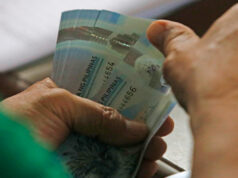GIR climbs to fresh record at end-August
THE COUNTRY’S dollar reserves hit a new record at end-August on the back of gains from the central bank’s investments abroad.
Gross international reserves (GIR) rose by 15% to $98.95 billion as of August from $86.03 billion a year earlier, data from the Bangko Sentral ng Pilipinas (BSP) released on Wednesday showed. GIR also climbed by 0.36% from the $98.6 billion logged at end-July.
The end-August tally is already above the central bank’s $90-billion projection for this year. BSP Governor Benjamin E. Diokno last week said the country’s dollar reserves could go beyond $100 billion by year-end.
Ample foreign exchange buffers protect the country from market volatility and ensure the country can pay its debts in the event of an economic downturn.
“The month-on-month increase in the GIR level reflected inflows mainly from the BSP’s foreign exchange operations and income from its investments abroad,” the BSP said in a statement.
Meanwhile, the rise was partially offset by foreign currency withdrawals use to pay debt obligations of the national government as well as revaluation losses from the central bank’s gold holdings amid a decrease in prices of the metal.
The BSP said the end-August tally is equivalent to nine months of imports of goods and payments of services and primary income.
It is also about 7.6 times the country’s short-term external debt based on original maturity and 4.8 times based on residual maturity.
Broken down, gold reserves stood at $12.039 billion, 50.19% more than the $8.015 billion seen a year ago but down 4.41% from the $12.595 billion logged as of July.
Gains from investments abroad, which made up the bulk of the reserves, jumped 12.1% year on year to $82.446 billion from $73.522 billion and by 1.56% from the $81.177 billion logged the month before.
On the other hand, foreign currency deposits dropped by 9.27% to $2.505 billion from $2.761 billion in the same period last year. It also decreased by 12.62% from the end-end-July level of $2.867 billion.
The country’s reserve position with the International Monetary Fund (IMF) rose by 33.8% to $753.7 million from $563.3 million a year ago and by 0.41% from $750.6 million the prior month.
Special drawing rights — or the money the Philippines can tap from the IMF — stood at $1.209 billion, 3.51% higher than the $1.168 billion seen a year ago and up a tad from the end-July’ level of $1.168 billion.
The continued rise in the country’s dollar reserves will help boost the peso, Rizal Commercial Banking Corp. Chief Economist Michael L. Ricafort said in a text message.
“Stronger recovery of OFW remittances may also contribute to higher GIR to uncharted highs in the coming months,” Mr. Ricafort added.
Cash remittances rose 7.8% year on year to a seven-month high of $2.783 billion in July, mainly fuelled by inflows from land-based overseas Filipino workers. However, the seven-month level of $16.802 billion was still 2.4% lower year on year.
The BSP expects a 5% decline in cash remittances this year due to the coronavirus crisis. — L.W.T. Noble



